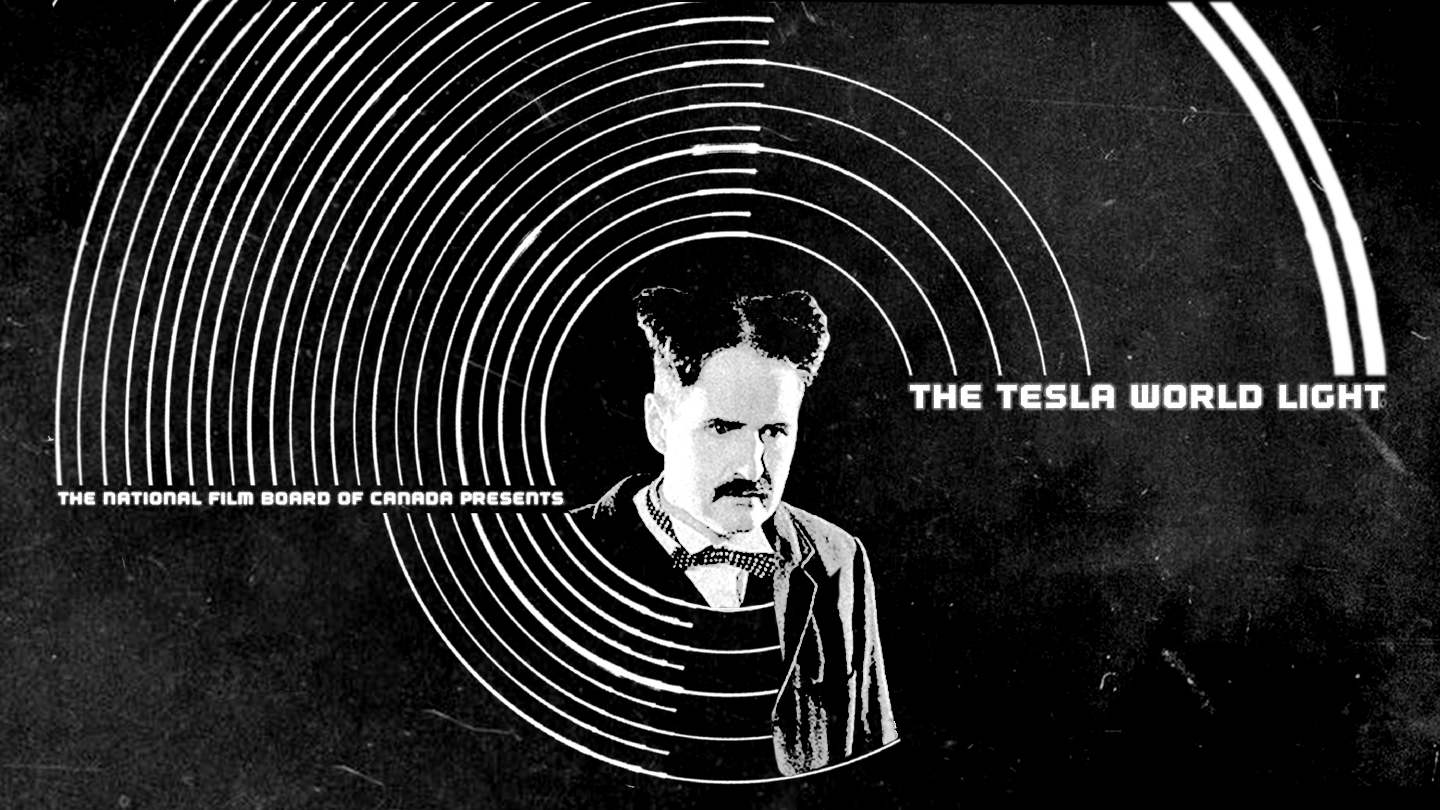Sometimes when you watch a film, you’re treated to different camera techniques, lighting techniques and sound techniques. Rarely do you see all three in one. I’m always inspired when I do watch a film that begs the question, how’d they do that? The film, The Tesla World Light, is filled with stop motion, light painting and visual music. The film’s creator, Matthew Rankin is in a category of his own. Pure brilliance. I was lucky enough to watch the film and be reminded of Nikola Tesla’s genius as well as his spiral into isolation and nervous breakdown.
The Tesla World Light is a fascinating piece of film that should be considered art. Shot in black and white, it is a tremendous testament to Nikola Tesla told in a way that fills every visual and sound sensory. This amazing story portrays Tesla in 1905 appealing J. P. Morgan, his onetime benefactor. The rejection is displayed in the film through intense visual acrobatics. Visually it exhibits light painting at its best. The other effects are hand made using a Bolex 16mm with stop-motion shooting. There is no CGI and although these effects are new to me the technique has been around since the last century. A dazzling display of creative painting combined with artistry and film manipulation, you’ll be so mesmerized you’ll forget about your popcorn. I was so very privileged to have the opportunity to speak with Matthew about this Canadian masterpiece. I knew I was in for an education.

“Having watched your film, it is filled with many effects. How did you achieve them?”
“For light painting you have to work in absolute darkness and dress in black, otherwise you’ll be visible. It requires a double exposure on every frame.
For example, working with the actor what we’d do with each frame is open the exposure, I’d move through it with my light source artistically creating some sort of movement then I and the light source would leave the frame. Then, we would flash this little flash bulb on the actor, a little flash bulb on the set, sometimes flash bulb on another element, sometimes there’d be some other element within the stop motion then we’d finally close the shutter. In some cases there’d be upward of five different exposures for each frame. It was very time consuming, elaborate and tricky to keep on top of. Nikola Tesla had taken many of the same photographs of himself. A favorite one of mine is with Tesla sitting in his laboratory with rays of electricity shooting violently all around him. It was a double exposure created from a long exposure. His technique is still photography but I set out to create movement using the same technique.”
Mathew considers his knowledge of cameras analog. He has no experience with CGI either. Most of the film was shot entirely with the Bolex and Matthew says it was very easy to operate. It’s a wind-up that gives you 30 seconds of filmmaking at a time. They were shooting one frame at a time so it was quite suitable for the purpose of the film. By applying the light painting technique it gives the film life and animation. Takashi Ito’s film, Thunder is a favorite of Matthew’s that has a bit of the light painting in it. It’s available on youtube.com and is a remarkable demonstration of abstract filmmaking. Matthew’s film is in good company.
In actuality, he wasn’t much more familiar with light painting outside of a couple examples but started to think how it would be a great portal-ism to tell a story about Tesla. He’s really interested in abstract imagery and the language, abstract cinema, abstract animation. His interest is in re-appropriating this abstract language to tell a story and build emotion, characters, etc. He explains it all in more detail.
“I was interested in Tesla and always loved electricity and had a fascination for it. At some point these two interests connected and I saw that this was a perfect formalism to make a film about Tesla because the raw material is light. He devoted his life to light and electricity. It was a form and content meeting point that I got excited about. So I started experimenting in different methods of light painting and it became more and more elaborate. I started to test how I could animate it, how it would move.”
He’d made two previous films with small amounts of light painting. Matthew is interested in abstract imagery and the language, abstract cinema and abstract animation. He goes on to translate the process of the effect.
“I experimented with it a bit. I understood a little about how to expose it and what’s involved shooting it frame by frame. It is tricky. You have to work in absolute darkness and dress in black otherwise you’ll be visible. It requires a double exposure on every frame.”
“Considering the film is historical, are you particularly interested in bringing more historical pieces into film?”
“It is the font of my inspiration, my observation post from where I look at things. My interest is in re-appropriating this abstract language to tell a story and build emotion/characters.”
Mathew considers Tesla a great utopian and indicates the world is currently without any utopians that are contemporary.
“We don’t have any leadership that gives us any hope for the future.”
It makes sense to Mathew that he’s re-entering the zeitgeist through the introduction of the Tesla car, cause he had this very grandiose vision of the future. He was however destroyed and crushed by the imperatives of his era. Perhaps people are seeking to re-evaluate what utopians were trying to tell us a century ago. Mathew says Tesla’s contribution to the world is bottomless. We benefit from his innovation daily. Much that we take for granted is ultimately rooted in Tesla’s thinking. His enormous contributions have gone unrecognized for a very long time. Ultimately what crushed him was capitalism. His vision of creating free electricity to the world led to his nervous breakdown because his financial backer, J.P.Morgan, saw no profit in it and refused to back him. It brought about the end of Tesla’s most creative period of invention. A sad ending for a genius that wanted to use his knowledge to benefit others.
“Where did you create all the effects and how long did it take?”
“I rented a studio and shot over the course of ten days with the actor, puppet and set. I then had a few more days of shooting at the animation stand working with silhouettes. After that there was a period of working on the celluloid, painting directly onto the film itself. That took about a month, probably the longest. It took a long time but animation always is. Working on movement frame by frame is long and time consuming, you need to be patient.”
“Had you ever considered shooting the film in colour?”
“The project was always intended to be black and white due to the inspiration from photographs Tesla had taken. Also, references to early abstract animation were also in black and white and worked well as an influence. With black and white you get less information on film as opposed to digital but on digital, black is actually light. In film, black is actually the absence of light. It’s where the emulsion has hidden light and prevented it from passing through the film. You can get true black and true light in a way you can’t get on digital. In colour, black has a quality of brown to it. Because the film is about electricity, that contrast is really important. To get that contrast is really beautiful and poetic in black and white.”
I strongly get the impression Mathew is an inventor himself. He took the images one step further by painting directly onto the celluloid with an Indian ink. The ink reticulates once it hits the celluloid. It gives the background a crackling effect. His technique allows him to then modify and literally animate the static by painting over the crackle with more opaque ink. He’d perfected the technique on his last film, The Mynarski Death Plummet. It also has a lot of hand processing on the celluloid. He used a lot of techniques on that one, including bleach, ink, coloured paint applied directly to the emulsion frame by frame. In the process of making it, he worked with a few black inks. Discovering it would crackle when dried, he didn’t use much of the effect because it didn’t fit with the story but knew it would be perfect for part of the Tesla film.
He wanted the music to match the pictures, inspired by artists, Oscar Fischinger and Norman McLaren. The idea is to create abstract images to look the way music sounds. Mathews approach was to create the music as the metaphor for a story rather than a piece of music. He wanted the abstract images to look and feel the way he imagined Tesla’s nervous breakdown.
“I was trying to get into those abstract short circuiting synapsis, that were overtaking them.”
Tesla’s relationship with birds and the pigeon in the film, coincides to some degree with his feelings of alienation from the world. In meeting pigeon fanciers, he says they recognize that there is a level of acceptance and tenderness with a pigeon that can’t be replicated with ones fellow humans.
The project was financed solely by the NFB. It was an internal production at the NFB studio in Montreal where Matthew lives. He exclaims it was a wonderful artistic experience. They burnt 15,000 sparklers to achieve the light painting effect and the bird in the film was resurrected from a dead pigeon the puppeteer found on the street.
Its Art director is Louisa Schabas and DOP was Julien Fontaine. The set design & special effects were accomplished by Dany Boivin. Compositing was created by Adrian Replanski. The actor portraying Tesla was Robert Vilar. Sacha A. Ratcliffe created the sound design and the music was composed by Christopher Lamarche then later mixed by Jean Paul Vialiard. The incredible ensemble was produced by Julie Roy.
The Tesla World Of Light has screened in Ottawa, Shortcuts category at TIFF, Official Selection Annecy, the Semaine de la critique at Cannes, in Sydney, the Wiesbaden International Weekend of Animation and will be showing at VIFF. I highly recommend watching this film.
He’s also just finished a feature film, currently in post. It’s about the youth of William Lyon McKenzie King, the prime minister of Canada from 1921 to 1948. It takes place in 1899 as he’s hesitating in love between two women while having a secret liaison with a shoe.
Matthew Rankin has a unique attraction to historic events. I’m always very fascinated when watching a film based on true events. Life is stranger than fiction and our history tends to shape our future. His films seem to marry the two distinctions as well as introduce us to events long forgotten. I look forward to more films by this innovative filmmaker.






